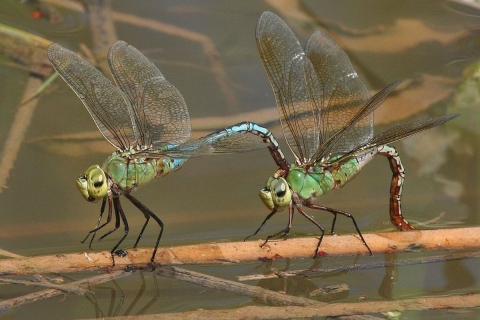They’re not dragons, and they’re not flies. But the stunt pilots of the insect world are attention-getters. They wear flashy colors, race at up to 30 miles per hour, boast ancestors that predate dinosaurs, mate in midair. Aggressive predators, they’re out for blood – but not yours. What’s not to love?
On national wildlife refuges, many visitors agree. “People are fascinated with finding dragonflies and damselflies [their biological cousins],” says David True, former refuge ranger at Aransas National Wildlife Refuge in Texas. “It is a growing thing.”
At Desert National Wildlife Refuge Complex in southern Nevada, where biologist Jeanne Tinsman volunteers, 43 species of dragonflies and damselflies have been documented. Tinsman can identify them all. She says folklore often whets people’s curiosity about dragonflies.
“For example,” she says, “when I was growing up, there was a story that dragonflies would sew your lips shut. They are also symbols of rebirth. I think people often key in on dragonflies because of these myths. Then people find the insects, and, of course, they’re bright and beautiful and colorful. Some perch a long time,” making them good photo subjects.
Dragonflies also sport fanciful names. Vivid Dancer, Sparkling Jewelwing, Furtive Forktail, Stygian Shadowdragon, Harlequin Darner, Dragonhunter and Ebony Boghaunter are some highlighted on a fact sheet at Aransas Refuge.
If, during your wanderings at Desert National Wildlife Refuge, you spy a woman with binoculars and a dragonfly hat, be sure say hi to Tinsman. And ask about dragonflies. “I love to share about them,” she says.
Dragonflies are not just native wildlife. They are also natural mosquito controls and indicators of clean water. Dragonflies are generally most abundant in mid- to late summer. Dragonflies and damselflies are members of the biological order Odonata, meaning “toothed ones.” (Don’t think about them as having teeth like ours; insects don’t have bones. But, explains True, “they do have mandibles that function similarly for grabbing and cutting food.”)
National wildlife refuges known for their dragonflies include:
Bitter Lake National Wildlife Refuge, New Mexico. More than 60 dragonfly species have been spotted on the refuge, including the rare Bleached Skimmer. Stop by the visitor center to see the collection of dragonflies there. Peak dragonfly viewing is in July and August.
Patoka River National Wildlife Refuge, Indiana. Refuge wetlands host 30 species of dragonflies and 13 species of damselflies, including some rare kinds. A printout available at the refuge office lists them. The Halloween Pennant dragonfly, named for its orange and black wings, can be found at almost any refuge oxbow or wetland from mid-June through early October.
Aransas National Wildlife Refuge, Texas. Dragonfly species you may see include Red Saddlebags and Wandering Gliders.
The four refuges that make up Desert National Wildlife Refuge Complex — Ash Meadows, Desert, Moapa Valley and Pahranagat National Wildlife Refuges — have a good mix of species, including the tiny Black-fronted Forktail and the Giant Darner.
The western United States’ sagebrush country encompasses over 175 million acres of public and private lands. The sagebrush landscape provides many benefits to our rural economies and communities, and it serves as crucial habitat for a diversity of wildlife, including the iconic greater sage-grouse and over 350 other species.
Learn more about sagebrush seedstalk at Seedskadee National Wildlife Refuge in Wyoming.
Did you know?
- Dragonflies boast two sets of wings, which they flap at about 30 beats per second.
- Dragonflies have huge compound eyes, which give them almost 360-degree vision.
- Dragonflies develop a taste for meat early. As nymphs, they snack on water insects, worms, mosquito larvae and small fish.
- When at rest, a dragonfly holds its wings open, either at right angles to its body or downward. A damselfly closes its wings, usually over its abdomen.
- Dragonflies don’t have stingers and can’t harm you.






